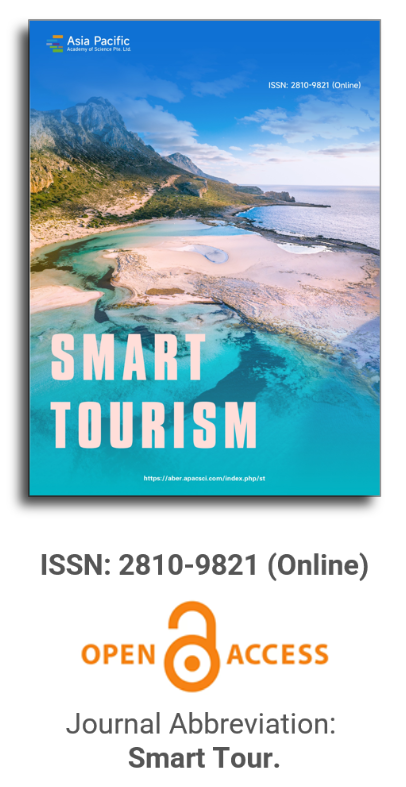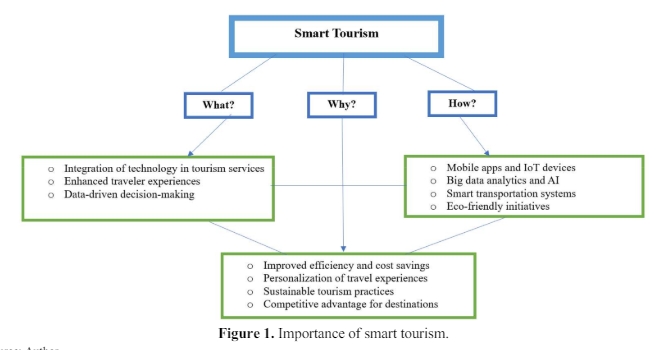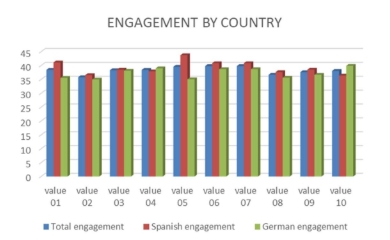


Evaluation system of urban smart tourism competitiveness based on AHP-entropy weight method
Vol 2, Issue 1, 2021
Download PDF
Abstract
In order to quantitatively evaluate the competitiveness of smart tourism cities efficiently and reasonably, a smart tourism city competitiveness evaluation system composed of four primary indicators such as infrastructure, economic basis, scientific and technological basis and environmental basis and 15 secondary indicators such as the number of mobile phone users at the end of the year and the number of urban Internet users is constructed, which is comprehensively weighted by hierarchical analysis method and entropy weight method. The empirical case of competitiveness evaluation of 13 cities in Jiangsu Province shows that the evaluation system can quantitatively evaluate the competitiveness of urban smart tourism comprehensively and objectively. The main factors affecting the competitiveness of urban smart tourism are urban infrastructure construction and economic foundation. Increasing investment in 5G, artificial intelligence and other information technology and enhancing urban economic strength are the key strategies to improve the competitiveness of urban tourism.
Keywords
References
1. Zhong W. Discuss the market competitiveness evaluation of smart tourism city. Vacation Tour 2018; (5): 62–64.
2. Fan L. Competitiveness evaluation of smart tourism city. Tourism Today 2018; (4): 14–15.
3. Hou B, Zhou X, Lu X. Construction and empirical analysis of urban cultural tourism competitiveness evaluation system: A case study of urban agglomeration in the Yangtze River Delta. World Regional Studies 2016; (6): 166–176.
4. Zhang J, Ji M, Zhu P. Research on regional tourism sustainable development based on multi-objective decision-making model: A case study of Tibet Autonomous Region. Industrial Economic Review 2011; (6): 83–89.
5. Song Y. The driving force and operating mechanism of the development of city’s business tourism: A case study of Suzhou industrial park [PhD thesis]. Suzhou: Suzhou University; 2012.
6. Xing X. Research on the evaluation of urban tourism competitiveness [PhD thesis]. Xi’an: Northwest University; 2014.
7. Wu K, Li X, Xie H, et al. Study on urban tourism competitiveness of Guangdong, Hong Kong, Macao Bay Area. Urban Insight 2020; (1): 52–62.
8. Xiong Y, Zhang Q, Hou K, et al. Tourism competitiveness and regional cooperation of cities around Dongting Lake from the perspective of global tourism. Economic Geography 2020; 40(7): 211–219.
9. Zhang S. Evaluation of urban tourism competitiveness in Hebei Province. Business and Economy 2020; (2): 31–39.
10. Liu Q, Liang L. Evaluation of development potential of smart tourism city in Henan Province based on G1-entropy. Journal of Luoyang Normal University 2016; 35(4): 21–27.
11. Liu L. Research on evaluation index system of smart tourism. Science and Technology Management Research 2013; (6): 67–71.
12. Liu S. Research on urban tourism competitiveness [PhD thesis]. Shanghai: East China Normal University, Shanghai; 2008.
13. Yan C, Liang L, Liu X, et al. Evaluation of urban tourism competitiveness based on factor analysis: A case study of 30 provincial cities in central plains economic zone. Areal Research and Development 2014; 33(1): 63–67.
14. Du P, Yang L. Research on the construction system and development strategy of smart tourism system. Science and Technology Management Research 2013; (23): 44–49.
15. Dai P. Research on the evaluation of tourism competitiveness of smart tourism cities: Research based on BP neural network model [PhD thesis]. Guilin: Guangxi Normal University, Guilin; 2015.
16. Wang E. Evaluation model and empirical research on the construction level of smart tourism city based on G1-entropy. Journal of Dalian University of Technology (Social Science) 2014; 35(2): 68–73.
17. Yao G. On the construction framework of “smart tourism”. Journal of Nanjing University of Posts and Telecommunications (Social Science) 2012; 14(2): 13–16.
18. Ding L, Wu X, Ding J. Construction and application of urban tourism competitiveness index. Economic Geography 2006; 26(3): 511–515.
19. Ma Y, Hu X. Comprehensive evaluation of tourism competitiveness of four cities in northeast china. Territory and Natural Resources Study 2006; (1): 67–68.
20. Yang J, Zhao W, Li W, et al. Comprehensive evaluation of ZhiJin cave smart tourism resources basedon AHP. Green Technology 2016; (21): 109–113.
21. National Bureau of Statistics. China Statistical Yearbook [Internet]. Available from: http://www.stats.gov.cn/tjsj/ndsj/2017/indexch.htm.
22. Department of Urban Social and Economic Investigation, National Bureau of Statistics. China Urban Statistical Yearbook. Beijing: China Statistics Press; 2017.
23. Jiangsu Provincial Bureau of Statistics. Jiangsu Statistical Yearbook [Internet]. Available from: http://stats.jiangsu.gov.cn/2017/indexc.htm.
24. Du Y, Gao K. Ecological security evaluation of marine ranching with AHP-entropy-based TOPSIS: A case study of Yantai, China. Marine Policy 2020; 122: 104223.
Refbacks
- There are currently no refbacks.
Copyright (c) 2021 Qigan Shao, Lianfeng Yang
License URL: https://creativecommons.org/licenses/by/4.0

This site is licensed under a Creative Commons Attribution 4.0 International License (CC BY 4.0).

Prof. Hung-Che Wu
Nanfang College, Guangzhou
China
Indexing & Archiving
Asia Pacific Academy of Science Pte. Ltd. (APACSCI) specializes in international journal publishing. APACSCI adopts the open access publishing model and provides an important communication bridge for academic groups whose interest fields include engineering, technology, medicine, computer, mathematics, agriculture and forestry, and environment.



.jpg)
.jpg)

.jpg)

